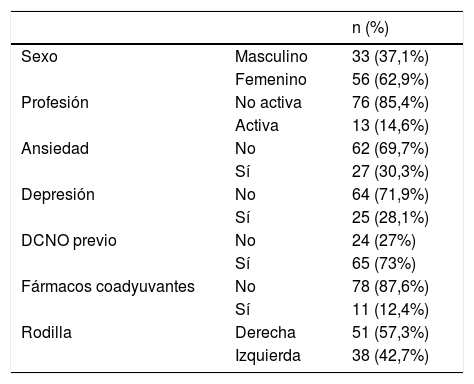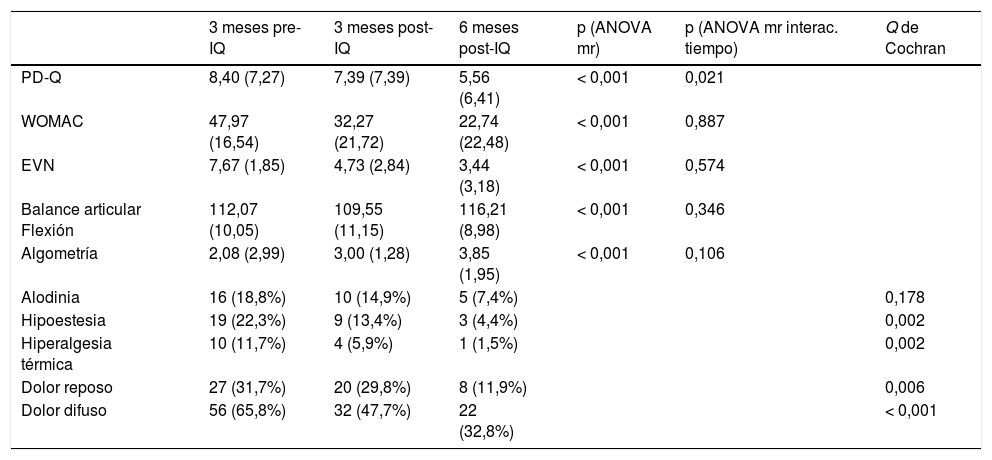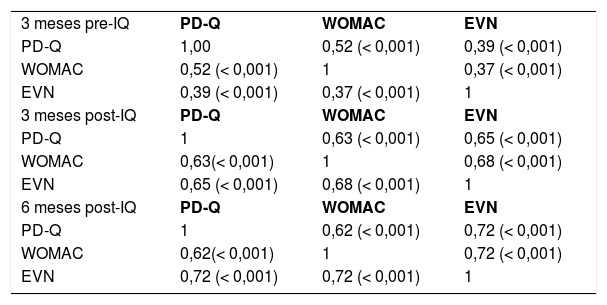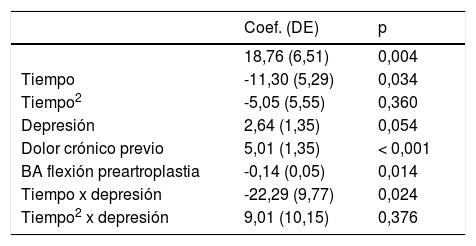En pacientes con artrosis de rodilla se ha identificado un 30% de asociación de dolor de sensibilización central (DSC). El objetivo es analizar la persistencia de DSC en pacientes tras artroplastia de rodilla y su correlación con la intensidad del dolor, funcionalidad y los factores determinantes asociados, además de evaluar la exploración física como instrumento de valoración.
Material y métodosEstudio cuasiexperimental antes-después de pacientes intervenidos de artroplastia total de rodilla. Se analiza la evolución de variables subjetivas (características del dolor, cuestionarios painDETECT, WOMAC y escala visual numérica) y de exploración física (hiperalgesia térmica, alodinia, hipoestesia, algometría y goniometría), tres meses antes y tres y seis meses después de la cirugía mediante el test de ANOVA de medidas repetidas para las cuantitativas y el Q de Cochran para las cualitativas. Se utilizó la prueba de Spearman para la correlación de los cuestionarios, del PD-Q y variables de exploración y para el modelo multivariante del PD-Q con determinantes clínicos.
ResultadosSesenta y siete pacientes completaron el estudio. La evolución de las variables cuantitativas y cualitativas fue significativa, con correlación entre cuestionarios. En el modelo multivariante lineal de PD-Q se obtuvo relación significativa de antecedentes de limitación movilidad en flexión, dolor musculoesquelético crónico y la asociación de depresión y tiempo.
ConclusionesUn porcentaje significativo de pacientes con artrosis de rodilla tras artroplastia persistieron con probable DSC, correlacionándose con intensidad y funcionalidad. La limitación de movilidad y comorbilidad crónica previas podrían ser determinantes de DSC, siendo la exploración y anamnesis, herramientas útiles en consulta.
In patients with knee osteoarthritis, a group of 30% has been identified with central pain sensitization (CPS). The aim is to analyze the persistence of CPS in patients after knee arthroplasty and its correlation with pain intensity, functionality, determining factors and to evaluate physical examination as an assessment instrument.
Material and methodsQuasi-experimental before–after study of patients operated on total knee arthroplasty. The evolution of subjective variables (pain characteristics, painDETECT questionnaire, WOMAC and Numerical Rating Scale) and physical examination (thermal hyperalgesia, allodynia, hypoesthesia, algometry and goniometry) 3 months before and 3 and 6 months after surgery are analysed using repeated measures ANOVA test for the quantitative ones and Cochran's Q for the qualitative ones. Spearmen test was used for the correlation of the questionnaires, the PD-Q and exploration variables and for the multivariate model of the PD-Q with clinical determinants.
ResultsSixty-seven patients completed the study. The evolution of the quantitative and qualitative variables was significant, with a correlation between questionnaires. In the linear multivariate model of PD-Q, a significant relationship was obtained from personal history of flexion limitation, chronic musculoskeletal pain and the association between depression and time.
ConclusionsA significant percentage of patients with knee osteoarthritis after arthroplasty persisted with probable CPS, correlating with intensity and functionality. The limitation of mobility and previous chronic comorbidity could be determinants of CPS, with anamnesis and exploration being useful tools in consultation.
Artículo
Comprando el artículo el PDF del mismo podrá ser descargado
Precio 19,34 €
Comprar ahora















